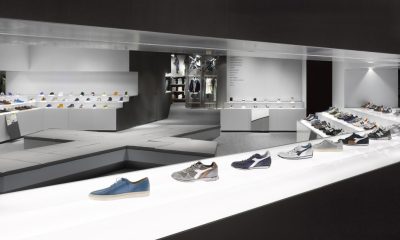FRCH Design Worldwide, a leading retail and hospitality architecture and design firm with a focus on consumer experiences where people work, shop, dine, play, stay and heal, is building renewed purpose for retail brands looking to expand their experiential equity with transient travelers in travel focused outposts.
At a time when retail is facing turbulent shifts within the industry, travel retail remains a strong, evolving opportunity within the market landscape. Brands have the opportunity to offer an animated repreieve from the intense travel annoyances attached to getting from point A to B.
“Travel retail presents an exciting opportunity within the evolving landscape of consumer brand experiences,” said Kelsey Chessey, Senior Brand Strategist at FRCH.
Consumers expect just as much from their airport experiences as they expect from any other engaging experience. Retailers and developers that focus on compelling experiences and utilize a forward-thinking approach to capture consumer attention will have a competitive edge in the years to come.
Advertisement
Chessey has expanded upon the main topics of focus within the growing travel industry:
1. Authentically Local
Consumers are traveling with a desire to experience cultures different from their own. Airports and travel that offer products and partnerships to create a sense of place and cultural appreciation set the bar high with exclusive experiences that leave visitors craving more.
FAR HORIZON: World cultures will begin to integrate themselves into the airports with planes develop augmented reality windows that act as “portals” to the destination.
Advertisement
-
Localized Fare: Chain restaurants will start to be replaced by local concepts that bring the local flair into the traditionally homogenized airport environment.
-
Experience Culture: Rentable pods within the airport are available to travelers that immerse them in the culture of various destinations, e.g. karaoke pods to help represent Japanese karaoke culture.
2. Creating an Ecosystem
No longer stuck behind security checkpoints or confined to traditional footprints, airports of the future must become more functional, efficient and develop exciting destinations that travelers look forward to visiting. Unlike struggling malls, airports have a constant source of potential shoppers, so the focus will shift from making money from airlines to making money from passengers through commercial revenue.
FAR HORIZON: Airports and the areas surrounding them become self-contained cities
-
Pack Less: Consumers no longer need to pack for their trips as they rent clothing from sources like Rent The Runway and pick up their clothes in the airport upon arrival
-
The New VIP: As the area around airports develop with restaurants and entertainment options, services derived from hospitality spaces become more common – including expedited transportation packages for users with security clearance from restaurant/hotel to gate.
-
Unepxected Retailers: Less conventional retail options, like Buy Buy Baby, Dicks Sporting Goods, and Target enter the airport and allow travelers to purchase or rent unexpected items they might’ve forgotten
3. Home Away From Home
With both domestic and international travelers spending more time in airports, there are many comforts from home they yearn for. Airports are starting to appeal to this need by offering services that bring home to the airport for those travelers, such as click-and-collect, clothing rental, and cozy lounges that kids can run free in while parents recharge their phones.
Advertisement
FAR HORIZONThe airport becomes a second home for frequent travelers
-
• Mobile : Eats: UberEats or similar partnerships allow for mobile food orders to be delivered to locations within the airport or set for pick up at a gate before or after a flight
-
• Personal Storage: Lockers paired with dressing rooms allow people to store their suits and other slippers and other things they want on regular trips
-
• Convenient Collecting: Gate pods that deliver items such as toiletries, food, or other purchases so that travelers don’t need to carry them after purchaseor include in their carry-on bag
4. Wandering Wellness
For leisure and business travelers alike, there is a desire to remove as much stress as possible from the travel experience. Achieving this means making mindfulness and wellness in the airport environment part of the overall experience rather than a possible step en route to the experience (the final destination). Airports are working to expand their service offerings to include modern definitions of wellness in a bid to cater to current and future travelers.
FAR HORIZON: Emerging wellness trends become mainstream and easily accessible
-
• Elevated Tracks: Indoor tracks that are elevated above the terminal are accessible to those who want to exercise without being confined to a treadmill
-
• Sensory Fitness: Immersive rooms can be rented out and change in theme to leave the user feeling transported and provide them additional health benefits
-
• Alternative Wellness: Non-traditional wellness options take over for traditional gyms as travelers continue to leverage alternative medicines, like crystals and essential oils infused into clothing and food
5. Adaptive Environments
Travelers consistently rely on their phones and other technology to help navigate their journeys. This provides an excellent opportunity to utilize adaptive technology to create dynamic experiences through environments that evolve based on the type of consumer visiting, traffic levels, weather, and things like delays that impact travelermoods. Pop-up shops that change throughout the day based on flight plans and automatic discounts for people whose flights have been delayed or miss a connection are example already in development.
FAR HORIZON: Customers regain control of each step in their travel experience
-
• Flexible Furniture: Gates have flexible seating that changes based on the type of traveler coming through – conversational layouts for families, individuals seating for solo travelers.
-
• Personalized Environments: Consumers change their own environments in seating locations, including the heat, airflow, and even aromatherapy scents.
-
• Themed Zones: Gates and terminals develop themes through lighting, seating styles, anddigital graphics that adapt to the time of day, season, and flight destinations.
About FRCH Design Worldwide
FRCH Design Worldwide, a NELSON company, is an international brand experience firm delivering architecture, interior design, graphic design, branding and consulting services, where people work, shop, dine, play, stay, live and heal. We provide our clients with strategic and creative solutions, grounded in meaningful insights that positively impact their environments. FRCH is privately held with offices in Cincinnati, New York and Los Angeles and a team of over 200 passionate experts. Our integrated NELSON network includes nearly 1,100 Teammates in more than 25 locations, combining collective talent, industry experience, service expertise and geographic reach to deliver projects across the country and around the world.

 Photo Gallery3 days ago
Photo Gallery3 days ago
 Headlines2 weeks ago
Headlines2 weeks ago
 Sector Spotlight2 weeks ago
Sector Spotlight2 weeks ago
 Headlines5 days ago
Headlines5 days ago
 Headlines1 week ago
Headlines1 week ago
 Headlines3 days ago
Headlines3 days ago
 Headlines2 weeks ago
Headlines2 weeks ago
 Designer Dozen1 week ago
Designer Dozen1 week ago




















